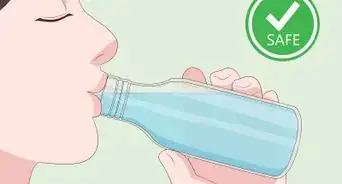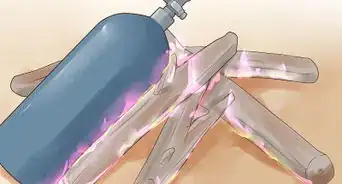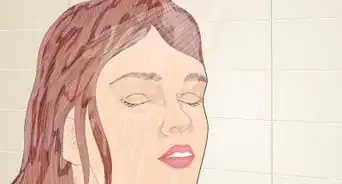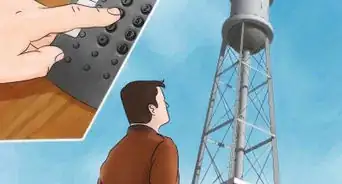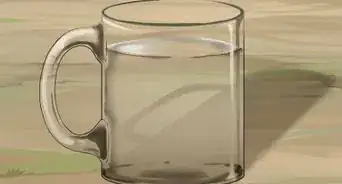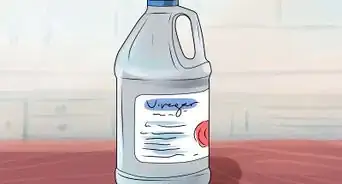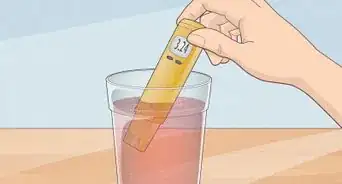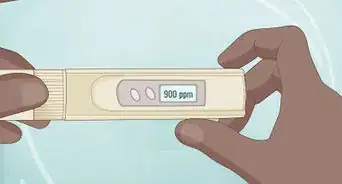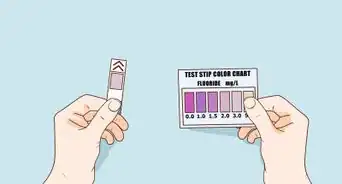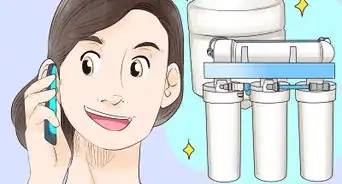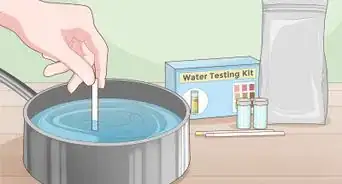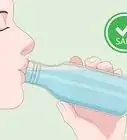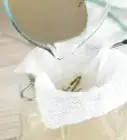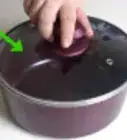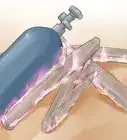This article was co-authored by Jennifer Lease, RD, CDN. Jennifer Lease is a Registered Dietitian and Trained Chef based in Denver, Colorado. With six years of experience in the food and nutrition fields, she specializes in a plant-forward approach to applying nutrition information to cooking. Jennifer holds a BS in Dietetics and a Dietetic Internship Certificate from The University of Delaware. She also received her professional chef training from The Natural Gourmet Institute for Health and Culinary Arts.
This article has been viewed 67,764 times.
When you don’t have access to clean tap water, knowing how to boil water is a necessity. Before you purify any quantity of water, you should filter it if it looks cloudy. Then, water can easily be boiled over a stove or another heat source. If heat isn’t an option, you can mix a small amount of a chemical solution into the water to cleanse it. Properly sterilized water is free of bacteria and other microscopic organisms, making it safe to drink.
Steps
Heating and Cooling the Water
-
1Filter the water before boiling it if it is cloudy. Cloudy water is caused by dirt and other debris you don’t want to drink. Let the water rest until the sediment settles at the bottom. Then, secure a clean cloth over a jar or another container with a rubber band. Pour the water onto the cloth, letting it drip through and into the container. When you've poured all the water through, remove the cloth carefully to avoid reintroducing sediment to the water.[1]
- You can also use a paper towel or coffee filter if you don’t have a clean cloth available.
-
2Bring the water to a boil over high heat on a stove. Pour the water into a pot safe for use on a stovetop if it isn’t already in one. Then, turn up the heat and wait until the water begins to bubble ferociously. Bubbles should rapidly rise from the bottom of the pot without pause.[2]
- If you’re familiar with cooking techniques, this is called a rolling boil. The water should bubble consistently before you set your timer.
- The water can take a while to bubble, especially if you’re heating large quantities. Expect it to take at least 5 or 10 minutes and reach a temperature of at least 212 °F (100 °C).[3]
- If your stove isn’t operational, you will need another heat source, such as a campfire or portable stove.
Advertisement -
3Boil the water for 1-3 minutes, depending on your altitude. If you are in an area 5,000 ft (1.5 km) or more above sea level, boil the water for a full 3 minutes. At altitudes lower than this, boil the water for at least 1 full minute. Boil it for longer if you are unsure about the altitude in your area.[4]
- You can find elevation information on a topographical map. Maps are available online or at your local government’s land survey office.
-
4Cool the water for 30 minutes before using it. Hot water takes a while to cool, so plan on boiling it before you need it. Test the water with a kitchen thermometer to make sure it won’t scald you. You can also hold your fingers close to the water to see if you feel any residual heat.[5]
-
5Improve the water’s taste by adding salt to it. Boiled water often tastes flat, similar to old soda, due to the loss of air. You can improve it by mixing in about 1 teaspoon (7 g) of salt per 1⁄4 US gal (0.95 L) of water. Stir the salt thoroughly in the water and add more if the taste still isn’t desirable.[6]
- Another way to improve the water is to aerate it again. Get another clean container and pour the water back and forth between the containers a few times.
-
6Store excess water in a clean, covered container. Any water you boil can be stored in case of emergencies. You don’t need plastic water bottles to do this. Mason jars, plastic jugs, and other resealable containers work well. Keep the container sealed to avoid contamination.[7]
- Boil and store water in advance! Then you will have a water supply no matter what circumstances you face.
Using Chemical Alternatives
-
1Disinfect water with chlorine bleach if you can’t boil it. You will need a regular, unscented liquid bleach and a sterilized eye dropper. Read the label to find out how much sodium hypochlorite is in the mixture. For bleach consisting of 6% sodium hypochlorite, add 8 drops per 1 US gal (3.8 L). For bleach consisting of 8.25% sodium hypochlorite, reduce the amount of drops to 6 per 1 US gal (3.8 L).[8]
- The water should have a slight chlorine smell before you drink it. If it doesn’t, repeat the treatment.
- If the chlorine taste is too strong, pour the water into another container to aerate it, then let it rest for a few hours.
-
2Mix granular calcium hypochlorite into the water for a stronger purifier. Granular calcium hypochlorite is very strong, so wear eye goggles and work in a well-ventilated area! Mix about 1 teaspoon (7 g) of calcium hypochlorite into 2 US gal (7.6 L) of water until it dissolves. Then, stir about 1⁄2 US gal (1.9 L) of the mixture into 12.5 US gal (47 L) of water.[9]
- If the water tastes too strongly of chlorine, pour it into another container and let it stand for a few hours.
- Granular calcium hypochlorite is used in pools, so you can find it wherever pool supplies are sold.
-
3Use household iodine if you don’t have chlorine available. Use a sterilized eye dropper to add about 5 drops of iodine to each 1⁄2 US gal (1.9 L) of water you want to purify. Add 5 extra drops if the water is cloudy. Stir the water thoroughly, then leave it alone for at least 30 minutes before drinking it.[10]
- You can find iodine in the pharmacy section at most general stores. Look for household iodine or tincture of iodine.
- Iodine may be included in commercial first-aid kits. Consider keeping a bottle on hand if your kit doesn’t have one already.
-
4Purchase water disinfection tablets for an easier way to clean water. Water disinfection tablets are by far the easiest purifier to use, but you may not already have them on hand. The tablets also come in a variety of strengths, so read the manufacturer’s instructions for handling information. Then, simply drop a tablet into the specified amount of water and let it dissolve.[11]
- Tablets are available at many pharmacies and sporting good stores, but they can also be bought online.
- You can get chlorine, iodine, and various other types of tablets. Using them means you don’t have to measure out any liquid chemicals.
- If you want to enjoy drinking water when you do not like the taste, try adding other flavors to your water.[12]
- You can add fresh fruit or herbs to it.[13]
- Or add fresh citrus juice (lemon, lime, orange) to it.[14]
Things You’ll Need
Filtering Cloudy Water
- Sterilized container
- Clean cloth, paper towel, or coffee filter
- Rubber band
Heating and Cooling the Water
- Stove
- Pot
- Salt
- Clean storage containers
Using Chemical Alternatives
- Chlorine bleach
- Granular calcium hypochlorite
- Household iodine
- Water disinfection tablet
References
- ↑ https://www.epa.gov/ground-water-and-drinking-water/emergency-disinfection-drinking-water
- ↑ https://www.cdc.gov/healthywater/drinking/travel/backcountry_water_treatment.html
- ↑ https://www.health.ny.gov/environmental/water/drinking/boilwater/response_information_public_health_professional.htm
- ↑ https://www.epa.gov/ground-water-and-drinking-water/emergency-disinfection-drinking-water
- ↑ https://www.health.ny.gov/environmental/water/drinking/boilwater/faq_residents_and_homeowners.htm
- ↑ https://www.epa.gov/ground-water-and-drinking-water/emergency-disinfection-drinking-water
- ↑ https://www.cdc.gov/healthywater/emergency/drinking/making-water-safe.html
- ↑ https://www.cdc.gov/healthywater/emergency/drinking/making-water-safe.html
- ↑ https://www.epa.gov/ground-water-and-drinking-water/emergency-disinfection-drinking-water
- ↑ https://www.epa.gov/ground-water-and-drinking-water/emergency-disinfection-drinking-water
- ↑ https://www.epa.gov/ground-water-and-drinking-water/emergency-disinfection-drinking-water
- ↑ https://batonrougeclinic.com/easy-ways-to-make-water-taste-better/
- ↑ https://batonrougeclinic.com/easy-ways-to-make-water-taste-better/
- ↑ https://batonrougeclinic.com/easy-ways-to-make-water-taste-better/
